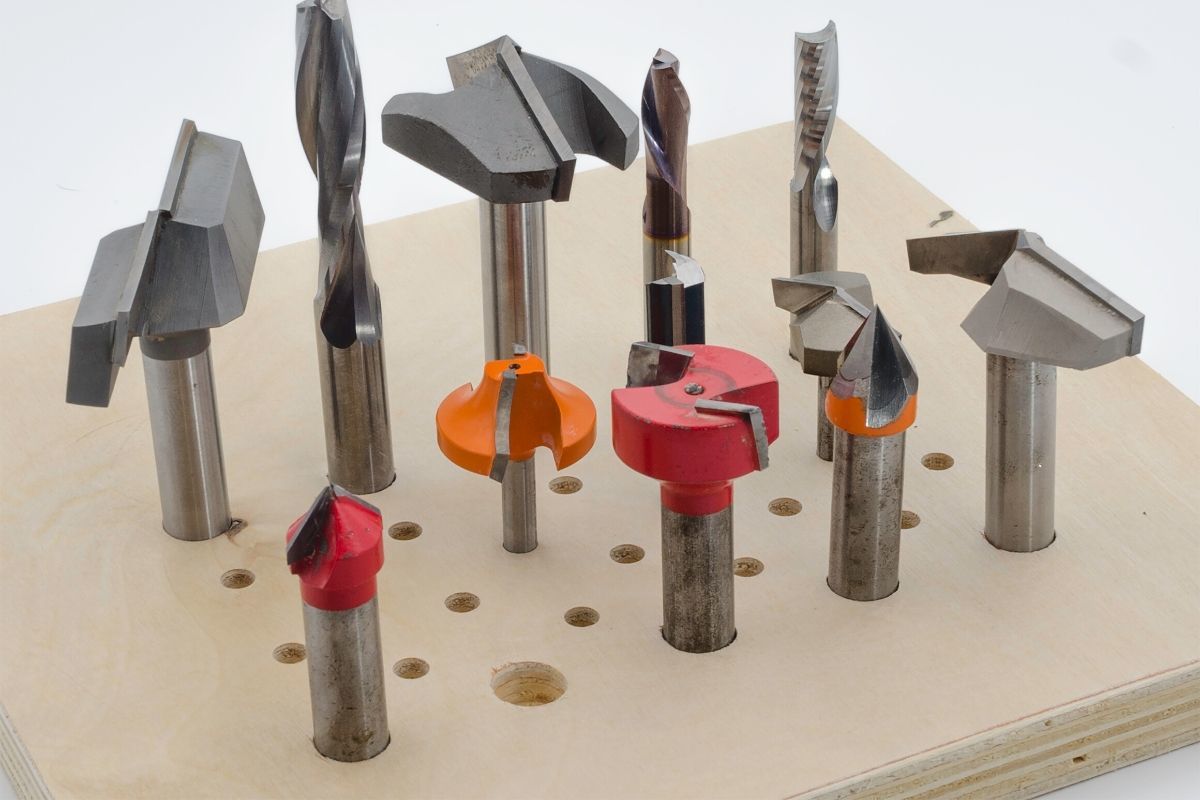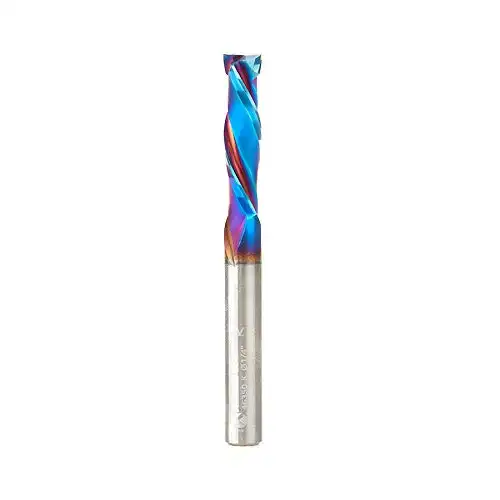The best CNC Router bit for plywood is a Compression 2 flute router bit. This uses a combination of up cut bits and down cut bits and hence, possesses the benefits of both types of cuts.
The tip of the bit is an up-cutter while the entire bit is a normal down-cutter. Thus, while cutting plywood or other materials, you will get clean edges on two sides since the bottom layer is pulled up while the top layer is pushed down.
In a hurry… Here’s Our Top Pick
The Amana Spektra Compression bit is the best overall cnc router bit for cutting plywood that we have reviewed. Reduces heat and while also eliminating chipping and burrs of the plywood. A great overall bit with a long tool life.
Our Rating
A combination of the two geometries removes chipping and decreases the risk of destroying the workpiece.
However, one drawback of compression bits is that it can never be used in drilling holes.
If the bits enter too deep, the direction of the bit can not be changed and the chip gets compressed since there is no room for escaping.
This causes heat and friction.
These extremely costly bits are sophisticated and are highly used for composites, plywood, and laminates.
CNC Router Bits For Plywood
Plywood is the most common man-made wood material used in the manufacturing of furniture. It consists of multiple strips and layers of wood placed in alternate directions and then glued into stable and strong sheets. Unlike solid wood, plywood does not shrink or expand when exposed to moisture.
The best way to cut the versatile plywood, CNC router bits are used such as TCT straight router bits, CNC compression spiral router bits, PCD diamond router bits, spiral router bits, straight carbide router bits, etc.
Router bits are used to easily cut the plywood into the desired shape and size to produce furniture. But remember, when cutting plywood you’ll still need a great dust collection system in place.
How to cut Plywood
Every CNC router requires bits that determine the resolution, material, and carving type. You can be creative with CNC machines; however, the magic belongs to the bit. The bits determine what design you’ll end up with. Moreover, the CNC router leads to a cut down of waste and hence, significantly reducing material costs.
The purpose of the bit is to cut the material in a specified way. The old routers were handheld tools guided by ball-bearing pilots or templates and it was used manually to cut plywood.
But the new CNC router is controlled by computers that exactly measure the toolpath. Without the bits, the routers cannot function or make complicated and intricate cuts.
The type of designs and materials cut by CNC router bits has become significantly diverse in nature. There are several types of CNC router bits too, available in almost every market.
Best CNC Router Bits
The most common CNC router bit is the spiral bit which is great for almost every purpose and it is used in many applications. However, you need to decide the direction of cut which will be based on the kind of material you are using and other such variables.
Up-Cut
Up cut bits drag the chips or the material up. While you are using them, the material needs to be held down in a very secure manner. This type of bits is most preferable when you want to remove chips from the cuts to avoid overheating of the bits. The up-cut bits make cuts through your material and this is the most commonly used cut.
Down-Cut
Down cut end mills press material and chips back into the table and the cut. The down-shearing action of the bits does a superb job by preserving the top surface of the material.
These down-cut bits are most preferable when you are cutting flexible and thin materials but they should not be used for drilling since the chips will push away the bottom-most layer from the bits.
However, the down cuts leave neat and clean cuts at the top layer of your workpiece but may tend to fray at the bottom.
Specialty Bits
You can choose from a variety of bits depending on the purpose or application of bits. Different bits help you make dovetails, drill holes, etch glass, and many more applications.
Below are some suggestions to give you an idea about the types of bits you will want to purchase right away –
- 60-degree V-bits (for sign carving and lettering)
- 2 flute, 1/4;” Up-cut end mill (preferable for general shaping and cutting)
- 30-degree, engraving bit (for detailed carving and lettering)
- 1/8″ end-mill
- 1/8″ ball-nose
- 1/8″ tapered ball-nose
- 1/16″ ball-nose
- 1/16″ end-mill
Speeds and Feeds
By feed and speed, we refer to two particular settings. Feed rate refers to how fast or slow a machine moves horizontally through the material. This is measured in inches per second or feet per minute.
Speed refers to the router or spindle revolutions per minute or RPM.
Every bit will have required feeds and speeds, that are normally provided by the manufacturers.
Chip load, on the other hand, refers to the size of the chip that the bit produces while cutting. The higher the feed rate, the larger will be the chips produced.
Higher RPM creates smaller chips. If the chips are too large, there is a risk of breaking the bit and if the chips are a fine powder, then the bit has become dull.
Chip load = Feed rate / (RPM * No. of Flutes)
Things to Avoid
While choosing a CNC router bit, know that stout and short bits will give you cleaner cuts. Going for extremely long bits will invite tool deflection or bending and vibration of the bit. These conditions tend to shorten the tool life significantly and make rough cuts.
The bits cause excessive noise as they cut. You will notice that larger diameter bits, for example, the 1/4;” bits, create less deafening noise.
If you want to produce sharp corners, you must use a 60-degree or 90-degree V-Bits. Any other bits will not produce sharp corners because of the radius. CNC router bits provide multiple cutting options for added flexibility.
If your bits have more flutes, it makes the tool stronger, and the feed rate thus increases, reducing the space for chip-flow. With more flutes, you will get a finer cut but will move through the material much slower and this avoids burning.
Hopefully, the information we have provided here at Maker Industry will help you make an informed decision on the best CNC router bit for plywood.
Related: Get an overview of CNC machines for makers.


